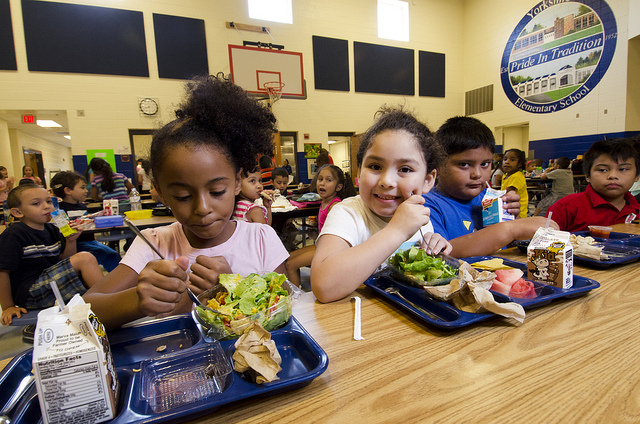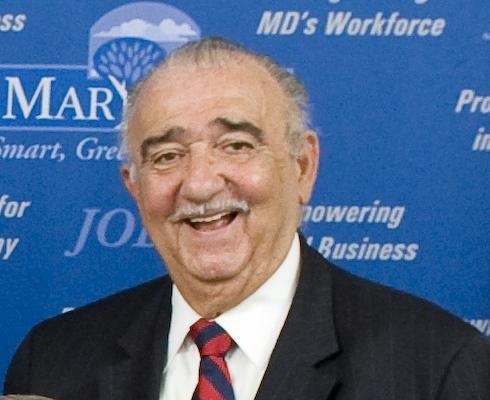Photo above by USDAgov with Flickr Creative Commons License
By Rebecca Lessner
For MarylandReporter.com
Through expanding a free meals program, legislators hope to come up with a simple solution for the complex question of enhancing student performance.
“Being able to reach your full potential during the course of the day, studying in school, is so dependent upon having school meal,” said bill sponsor, Del. Keith Haynes, D-Baltimore City. “Many times this is the only meal our students receive, a balanced meal, throughout the day.”
The Hunger Free Schools Act, HB 965, was signed into law last week by Gov. Hogan.
According to Michael J. Wilson, director of Maryland Hunger Solutions, schools in 22 counties and the City of Baltimore may now qualify for free breakfast and lunches without risking a loss of state funding.
The bill will encourage more participation in a program that allows schools to do away with household applications for federal meal funding — instead, an entire school with at least 40% of low-income students will be provided free lunches and breakfasts.
Big impact for Baltimore City
Chief Executive Officer of Baltimore City Public Schools, Gregory Thornton, called the bill an “all around win.”
“I am excited that…all city schools students can eat a healthy breakfast and lunch at school for free,” said Thornton. “The new Community Eligibility Program (CEP) means that families no longer need to fill out detailed paperwork to apply for free or reduced-price meals and the district no longer needs to process thousands of forms.”
Haynes, who represents Baltimore City, is hopeful all the schools there will participate in free meals, since 150 schools in the city have more than 55% qualifying students.
Sen. Richard Madaleno, D-Montgomery, was the sponsor of the Senate version of the bill and said it will help Baltimore city schools take advantage of federal programs.
“This is a simple solution that can have a big payoff,” said Madaleno. “But because we often look at poverty and the causes of as being so complex, we think sometimes the best solutions have to be equally complex.”
A Free and Reduced Meals Program is already in place, thanks to the Healthy, Hunger-Free Kids Act.
The Community Eligibility Program (CEP) now allows entire schools to qualify, versus individual students.
Maryland schools have been able to participate in the pilot program for CEP beginning the 2013 school year. However, only 23 Maryland schools are utilizing it.
Bill will protect schools from funding drops
Schools were not participating due to concern they would lose state funds, flowing through separate aid programs that rely on the federal meals documentation for funding calculations. The new law will provide a “floor,” foreseeing the federal meals count for fiscal 2017 and 2018 will drop as parent stop filling out forms. This softens a blow in compensatory aid funding for school systems that choose to participate in Community Eligibility Program for fiscal 2017 and 2018.
It was an important issue for schools — the state plans to hand out $1.3 billion in the 2016 budget in aid that is dependent on those per-pupil poverty calculations.
“It was just trying to clear up this one administrative hurdle that was in place,” said Madaleno.
The law also calls on the Adequacy for Funding Education in Maryland Study being done by the Maryland State Department of Education to look for indicators of poverty other than eligibility for the federal meals subsidy. This study will identify economically disadvantaged students for use in the state compensatory education formula by June 30.
“It is a balancing act,” said Superintendent of Somerset County Public Schools, John Gaddis, who last year began giving free meals to all students within its 10 schools.
The reason Somerset could afford to enact Community Eligibility Program in all of its schools early was because the high percentage of poverty-level students. The potential for federal reimbursement outweighed the costs of losing state-funds.
For Somerset, a 3% loss of state-funding equaled $100,000. But for larger districts the costs could be much higher.
“The bill that was signed took that off the table, I think now school systems, the big, urban school systems in Maryland are going to look at the program again and find that it’s very beneficial,” said Gaddis.
According to MSDE, the maximum federal reimbursement for free breakfast and lunch, based on a 180-day school year, amounts to $925 per child.
Less embarrassment, more participation
Students who qualified to receive free meals in the past may not have signed up, due to the embarrassment of being seen as poor by peers. Gaddis has found the largest percentage of Somerset county kids not eating in previous years were high school students, too embarrassed to enroll in a reduced price meal plan.
Now when a school qualifies, low-income students and higher income students will all qualify to receive free meals.
Students are also reported to be more engaged, well-behaved and active in classroom participation.
Howard and Washington counties are also already utilizing the program in some of their schools and now plan to expand.







So what happens on weekends, snow days, holidays, winter break, summer? Are these kids not being fed at home? Guess we’ll see an extension of the summer program that buses in free lunches to neighborhoods. When does it stop?
Hey, all of you who support this travesty…
“Free meals are not free ” !
Pay for it out of your own pockets, not mine !
BTW, these hungry students’ parents probably get food stamps and welfare… They should be feeding their own children !
Don’t breed them if you can’t feed them !
More welfare spending only attracts more illegal aliens and more degenerates to Maryland.
The Hunger Free Schools Act simply brings into MD a bunch more Federal money that became available in 2013 when Federal CEP program rules were liberalized.
Feeding kids is the parents responsibility. And to the extent parents receive SNAP (food stamps) benefits that are supposed to pay for their kids food, it seems like double counting.
The irony is these kids may rue the day their parents voted Democrat when it comes time to repay the Federal debt they will inheriting.
If you believe they’ll even be a Federal Government around when these children are old enough to be concerned about paying a Federal debt, you’re a lot mor optimistic than I am.
Sad. The culture of government dependence continues to grow.